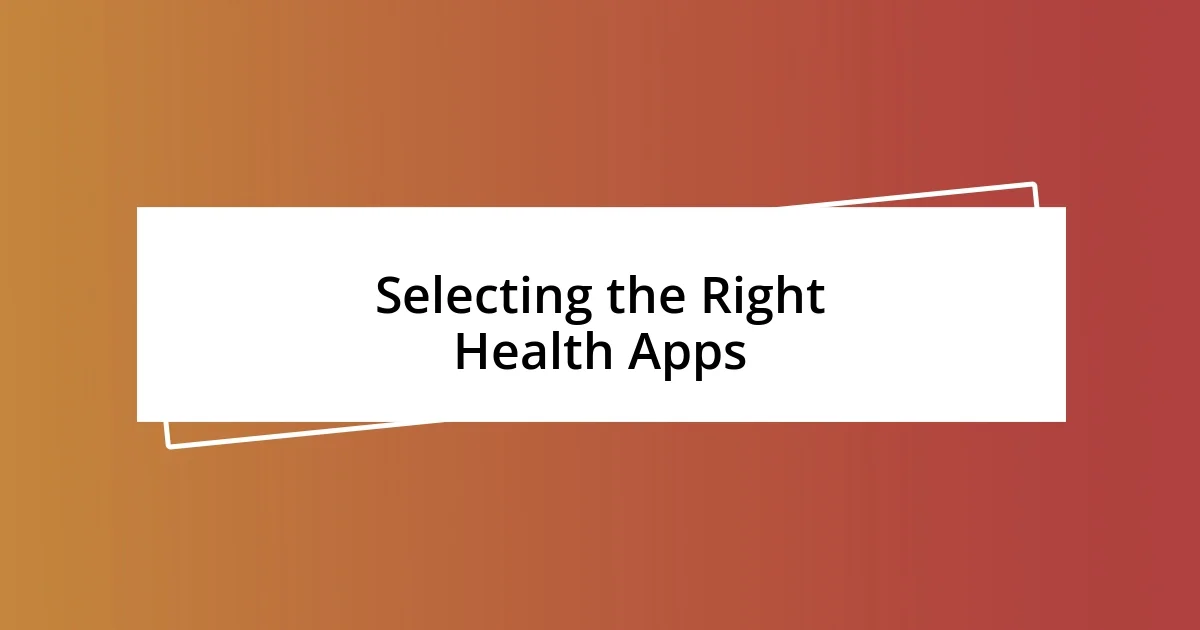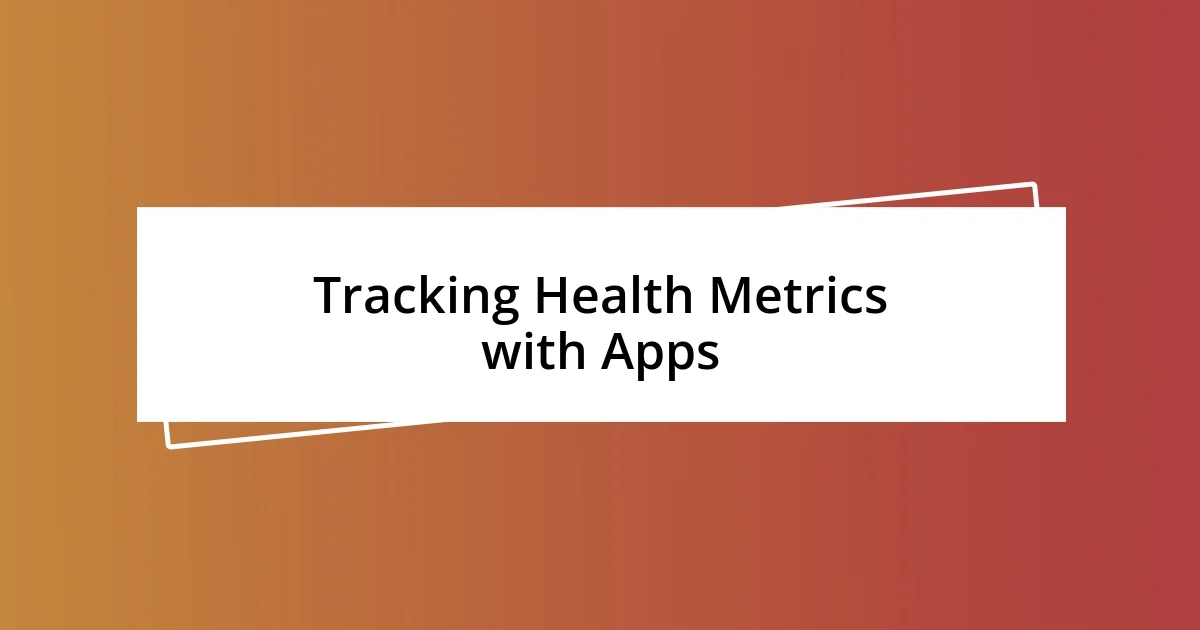Key takeaways:
- Technology, including wearable devices and telemedicine, greatly enhances healthcare access and personal health management.
- Selecting health apps should focus on user experience and features that align with personal health goals.
- Tracking health metrics through apps fosters accountability, community support, and ultimately promotes positive lifestyle changes.

Understanding Technology in Health
Technology has transformed the health landscape in ways I never imagined. I remember the first time I used a wearable fitness tracker; it was a game changer for my daily routine. Suddenly, tracking my steps and sleep felt personal and motivating, almost like having a coach on my wrist.
One of the most profound realizations I’ve had is how telemedicine bridges gaps in healthcare access. I vividly recall a time when I couldn’t see my doctor due to scheduling conflicts. Using a video call to discuss my health concerns was not only convenient, but it also ensured I received timely advice. Have you ever had a similar experience where technology made healthcare more accessible for you? It’s incredible how a simple tool can eliminate barriers that once felt insurmountable.
As I delve deeper into the world of health apps, I find myself amazed at the wealth of information available at our fingertips. For instance, I often use nutrition apps to plan my meals, making healthier choices easier than ever. It’s like having a personal nutritionist available anytime. When you think about it, isn’t it empowering to have such resources that actively support our wellness journey?

Types of Health Technologies
When it comes to health technologies, I’ve discovered several types that truly enhance my well-being and make daily health management much easier. One of my favorites is mobile health apps, which I turn to regularly for tracking various aspects of my health journey. Just the other day, I logged my water intake and noticed how it helped me stay more hydrated. It’s as if the app has become a little nudge, reminding me to sip throughout the day.
Here are some key types of health technologies that I’ve found particularly impactful:
- Wearable Fitness Devices: These include smartwatches and fitness bands that monitor activity levels, heart rate, and sleep patterns.
- Telehealth Services: Platforms that allow remote consultations with healthcare providers, making it easier to seek care without the hassle of travel.
- Health Apps: Applications dedicated to fitness, nutrition, and mental health that provide tailored guidance and companionship.
- Electronic Health Records (EHR): Digital versions of patients’ paper charts that facilitate easier access and sharing of medical history.
- Health Monitoring Devices: Tools like glucometers and blood pressure monitors that help users keep track of specific health metrics from home.
Each of these technologies plays a vital role in promoting not just healthcare access but also personal responsibility in managing our health. I’ve found that pairing these tools with a committed mindset can truly amplify their effectiveness.

Selecting the Right Health Apps
Selecting the right health apps can feel overwhelming given the plethora of options available today. I remember sitting in front of my screen, scrolling through countless apps, unsure of which would truly make a difference in my life. What I found helpful was seeking out apps that received high ratings from users and had positive reviews focused on usability. Once I narrowed down my choices, I opted to try a few out and quickly realized that the user interface really matters. If an app feels complicated, I tend to abandon it. Have you ever downloaded an app only to delete it after a few frustrating attempts?
As I dove deeper into my app selection journey, I began to focus on specific features that aligned with my health goals. For example, when choosing a nutrition app, I looked for one with a barcode scanner and a robust database. This allowed me to quickly track my food intake, which revealed patterns I didn’t notice before. I also appreciated apps that provided community support; reading about others’ experiences was both motivating and comforting. The social aspect made my health journey feel less isolating.
Here’s a comparison of a few popular health apps that I’ve considered in my quest for the right tools:
| App Name | Main Features |
|---|---|
| MyFitnessPal | Calorie tracking, barcode scanner, database of foods |
| Headspace | Meditation and mindfulness exercises, sleep aids |
| Fitbit | Activity tracking, sleep monitoring, community challenges |
When selecting health apps, I’ve learned to prioritize those that resonate with my personal needs and lifestyle, combining practicality with a touch of motivation. Trusting the process and staying open to exploration has truly enriched my experience.

Using Wearable Devices Effectively
I’ve found that using wearable devices effectively really hinges on understanding what features work best for me. For instance, when I first started using my smartwatch, I was overwhelmed by all the data it provided. I quickly realized that focusing on my daily step count and sleep quality made a significant difference in how I approached my health. Have you ever looked at your step tracker and felt motivated to push just a little further? That was my experience—it turned into a fun little challenge.
Another aspect that’s transformed my usage of wearables is setting specific health goals. At one point, I decided to improve my sleep schedule, so I began relying on my watch’s sleep tracking feature. The insights it provided helped me identify patterns that were affecting my rest. It’s amazing how much you can learn about your habits when you have the right technology guiding you. I recall being shocked to find out just how often I’d wake up during the night! To this day, I’ve adopted a more consistent bedtime routine, and it’s been a game-changer.
Consistency is crucial; I wear my fitness tracker every day, which helps reinforce my intentions. It’s like having a little cheerleader on my wrist, encouraging me to hit my targets. But I also learned to be flexible with it. There were days when life got hectic, and I couldn’t hit my step goal. Instead of feeling defeated, I embraced those moments, knowing that the overall journey is more important than daily perfection. This mindset shift not only eases the pressure but also makes the experience enjoyable and rewarding.

Integrating Telemedicine in Care
Integrating telemedicine into my healthcare routine has been a game-changer for me. I still remember the first time I used a telehealth service; it was during a time when I wasn’t feeling well, but making a doctor’s appointment felt like climbing a mountain. With just a few clicks, I was connected to a healthcare professional from the comfort of my couch. Isn’t it remarkable how technology can break down barriers to access?
What really stood out to me was the convenience of having my medical concerns heard without the usual stress of waiting rooms. I could have a video consultation in my pajamas, sipping on tea, all while maintaining my privacy. I felt valued and understood, as if the healthcare system was finally working for me instead of the other way around. Have you ever wished that you could talk to a doctor without the hassle? That’s exactly what telemedicine offers—a direct line to care.
One of the most significant benefits I’ve experienced is the improved follow-up care. After a recent visit regarding a chronic issue, I was able to schedule a follow-up appointment at my convenience, without the need to take time off work. Plus, I could access my doctor’s notes online, which empowered me to stay informed about my health journey. It’s empowering to take charge, right? Knowing that I have continuous access to my healthcare provider has made me more proactive about my wellness. I’ve felt more in control and confident in managing my health, and that’s something I truly value.

Tracking Health Metrics with Apps
Tracking health metrics with apps has become a cornerstone of my wellness journey. I remember the first time I downloaded a health app; it felt like unwrapping a gift. Suddenly, I could monitor everything from my calorie intake to my hydration levels. Have you ever been surprised by how much you drink in a day? Tracking my water intake using an app opened my eyes to just how dehydrated I often was, pushing me to make necessary changes.
As I delved deeper into the world of health apps, I discovered the power of setting personalized reminders. For example, I set daily notifications to check my blood pressure. Initially, I hesitated to use this feature, thinking it could become annoying. But, surprisingly, it became a comforting nudge—a little reminder that someone cared about my health. It’s incredible how a simple notification can transform into a self-care ritual. Have you ever felt like you needed that extra little push?
Over time, I began to appreciate the social aspect of tracking health metrics with apps. Joining community features within these apps often led to unexpected support. I vividly recall sharing my fitness milestones with a group online—a rush of encouragement flooded in. It’s that feeling of camaraderie that sparked my motivation even on days when I felt drained. Plus, being part of a community made me more accountable. Have you ever cheered for a friend’s success and realized it fueled your journey too? It’s proof that we’re all in this together, and having technology bridge those connections is priceless.

Evaluating the Impact on Wellness
Evaluating the impact of technology on my wellness has opened my eyes to the subtle yet profound changes in my day-to-day life. I distinctly remember a week when I turned on my meditation app every morning. Each session not only helped ease my anxiety but also seemed to set a positive tone for my entire day. Have you ever noticed how a few moments of mindfulness can reshape your perspective? I certainly have.
Another area where I’ve found technology to be immensely beneficial is in connecting me with health professionals beyond just doctors. I once participated in an online workshop for stress management, and it was like breathing fresh air. Interacting with specialists and a community of like-minded individuals made me realize that I wasn’t navigating my wellness journey alone. This sense of support, amplified by technology, has fostered a feeling of belonging that’s been incredibly uplifting.
Moreover, I’ve experienced a noticeable boost in my physical activity levels. Using a fitness tracker, I began to notice patterns in my routines—like how I often took fewer steps on days when I didn’t make time to break from work. It was eye-opening! Have you ever caught yourself in a cycle of inactivity and wished for a gentle nudge? That’s exactly what I received, translating to not just a number on a screen but a more energetic and healthier me. Technology isn’t merely a tool; it can truly be a catalyst for positive change in our wellness journey.














